My findings regarding COVID-19
What I have found about COVID-19
in search of the protection measures for Watsu
As I’ve been researching for protection measures for Watsu against COVID-19, I would like to make a note and share some findings. It’s really important for us to keep updating on scientific findings and also to organize our findings and make logical assumptions because there are still many things that we don’t know about this virus. I think it’s our professional responsibility to keep building and organizing the knowledge because, even though we may not care much personally for ourselves, our clients can be more cautious than us and we should be able to explain where we stand.
Table of Contents
- 40% false-negative by PCR testing
- Fogging HOCI is not safe
- Facemask can reduce releasing aerosols,
but cannot save you from inhaling them. - Electrostatic filter in a surgical mask
- A wet mask is no good? Because,,,?
- Coughing can penetrate the mask
- 80% air leaks from the side of the mask
- Don’t use a mask with a valve
- Ventilation is the best protection for Aerosols
- Choose your protection level of appropirateness
FINDING 1
40% false-negative by PCR testing
Did you know that PCR test can miss 40% of the infected? If there are 100 infected people, PCR test can detect infection from the average 60 people and call the other 40 people false-negative. And this 40 people will go about their ways, believing that they are not infected. The test misses 1 out of 3. This is a huge number.
How can that be?
This is how it happens. The accuracy of PCR testing depends on how many days one has been infected. On the day of infection, PCR testing cannot detect the infection at all. 100% false-negative. From the zero accuracy, it goes up as days pass by. 33% on Day 4. It means that the test can catch 1 out of 3 for positive, and miss the other 2. It continues to rise to the best accuracy of 80% on Day 8. And then it slowly goes down again. In most cases, one develops symptoms around Day 5. 3 days into the symptoms and they still miss 1 out of 5. The accuracy isn’t high.
False negatives: how accurate are PCR tests for COVID-19? by BioTechniques →
Also, another study shows that 40% of the infection comes from close contact with the infected person with no symptoms or before symptoms.
Temporal dynamics in viral shedding and transmissibility of COVID-19 by Nature Medicine →
It’s probably wise to assume that anyone can be a carrier or “I can be a carrier”
FINDING 2
Fogging HOCI is not safe
Hypochlorous acid, or HOCI, is a very efficient disinfectant, very safe to humans too. In fact, HOCI is not registered as a disinfectant in Japan, but as a food additive. (The guideline still says you should wash it off before eating.) It is proved that HOCI can kill the virus very effectively. It is a very unstable liquid. You should store it properly and use it before expiration, which is usually a few months. After the expiration, it becomes just water.
Many people must have seen HOCI fogging in the footage of the Korean invention of drive-thru PCR testing which shows they fog all over the medical professionals before they come out of the protective suits. It’s the same procedure in many research labs for high-risk infectious diseases. Also, I’ve seen some big buildings like business centers fogging people passing at the entrance.
Maybe because of these images, now I see many products in the market for fogging HOCI in your room. Maybe because the common protective practice for influenza is humidifying the space, people started thinking “Why not put HOCI in the humidifiers?”
But fogging HOCI to disinfect the surface is totally different from constantly fogging and inhaling the chemical. HOCI should be safe to touch, and somewhat safe to absorb by mistake. But constantly inhaling HOCI isn’t a good idea. HOCI is quick to react with organic matters to oxidize them. That’s how it kills germs and viruses. You don’t want that to happen much inside your body.
FINDING 3
Facemask can reduce releasing aerosols,
but cannot save you from inhaling them.
We know this virus can transmit by droplets. Droplets vary in sizes. Big droplets catch gravity and drop to the ground within a 2-meter range. But small particles like 5µm or smaller can hang in the air for quite a long time. They call it aerosols. And aerosols can carry the virus. A study shows that the virus in the aerosols can survive 50% for 1 hour, 10% for 3 hours.
That is why they tell you to avoid 3Cs.
- Close contacts with people
- Crowd of people
- Closed space with poor ventilation
Now let’s talk about the facemask.
Facemask works well for going out, but not so well for coming in.
Why is it like that?
First, we have to face the fact that our regular masks leak the air from all sides. That seems to me like the most significant difference from the medical N95 mask. A study shows 80% air can leak from the side of the regular mask (a surgical mask or a cotton mask) if you don’t wear it correctly.
This is how a mask reduces releasing aerosols. We release the aerosols when we cough, sneeze, laugh, or even talk. When the aerosols are released from the mouth, they hit the mask filter right away, and the particles start bumping into each other and they cannot fly straight. This is called Brownian motion. Just like a break shot in billiard, the particles fly zigzag all over the place inside the mask and many get captured by the filter before the air penetrates through the filer or leak from the side. Brownian motion makes the mask effective in reducing the release of aerosols even if the mask leaks from the side.
However, once the aerosols are out in the open air, hanging weightlessly, they go where the air flows. And they can come into your mask from the side without any disturbance. Because Brownian motion doesn’t happen where the air flows freely.
I picked up this image from a Taiwan website, which illustrates the point well. They did a fantastic job that should be a role model for the rest of the world. I think they had this up to warn people to wear masks in public spaces as early as late January.
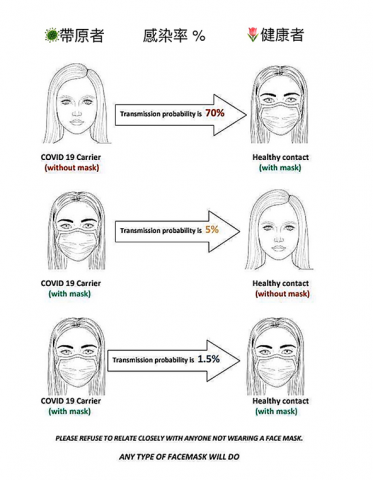
We wear masks on behalf of others. But if all people wear masks and keep the air safe, that way we can protect ourselves.
FINDING 4
Electrostatic filter in a surgical mask
Masks like N95 or a surgical mask use non-woven chemical fabric for filtration. It’s layers of fine fibers of polyester and polypropylene, running in all directions, compressed and electrified. A cotton mask, on the other hand, is woven by threads. There are gaps regularly, and the gaps can be pretty big.
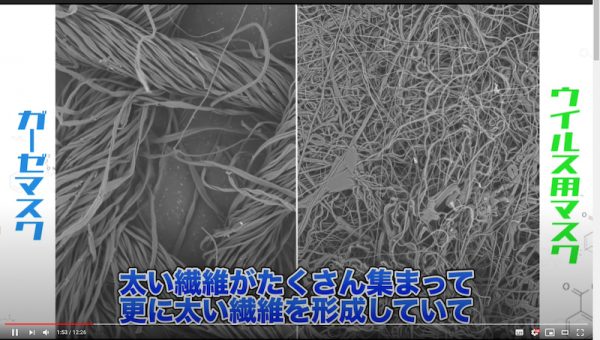
Microscope view of the cotton cloth on the left, non-woven cloth on the right.
Non-woven cloth is a better filter for 2 reasons. The first is because non-woven cloth makes more Brownian motion. The second is because it carries electrostatic to suck in small particles.
There are 2 kinds of filterings in masks. One is mechanical filtering. It catches particles by the filter fibers (“interception”) with the help of Brownian motion. This type of filtering is good at catching bigger aerosols like >0.3µm. Smaller particles can slip through the openings of the interception.
The other is electrostatic filtering. Chemical fibers can hold electrons for longer than natural fibers like cotton. The electrostatic can suck in particles that are smaller than the gaps of the fabric. It’s good at picking up smaller aerosols like <0.3µm. Bigger particles can hold enough weights and velocity to break free of electrostatic attraction.
Here’s a very informative article by ACS Publications.
Aerosol Filtration Efficiency of Common Fabrics Used in Respiratory Cloth Masks →
The study shows that a tight-woven cotton cloth can be very good filtering, almost as good as N95 and a surgical mask, even though it doesn’t hold the electrostatic filtering. A cotton mask is washable because it doesn’t have electrostatic, and you should wash it everyday because the cotton holds moisture that helps germs to develop.
The only concern about a cotton mask is that the better the mechanic filtering becomes, the tougher the breathing gets through the mask. The tougher the breathing gets, the more the mask leaks the air from the side.
FINDING 5
A wet mask is no good? Really?
Many people say, “You should change the mask when it’s wet.” just as the mask manufacturers.
But why?
I have been trying to see if the cotton mask is also not good when wet. Or a surgical mask can be no good at all when wet. I looked but have seen no evidence or good reasoning except a few related information.
A surgical mask manufacturer explains that we shouldn’t wash the surgical mask for reuse because the mask will lose electrostatic filtering when wet. Even the moisture of our breath can reduce the electrostatic within several hours. The mask should be used just for one day and disposed.
I found another Japanese study that shows spraying alcohol to disinfect the mask can reduce the filtering efficiency.
- N95 mask which filtered 99% of 0.3µm particles reduces to 65% after spraying.
- A surgical mask which filtered 94% of 0.3µm particles reduced to 90% after spraying.
The study concluded that spraying alcohol probably removed the electrostatic from the mask. N95 mask lost the filtering efficiency greater than the surgical mask, probably because N95 relies more heavily on the electrostatic filtering. This confirms that it is a medical field that emphasizes to change N95 mask when wet.
Another input is from ACS Publication I mentioned above. They discussed that chemical fibers can hold more electrostatic and for longer time than natural fibers. Because natural fibers pick up moisture. A cotton cloth does not have electrostatic in the first place because it’s wet already, so to speak.
Now, it’s time to make a logical assumption of our own.
Does a cotton mask lose the filter efficiency when it’s wet or a little damp in the pool?
I don’t think so.
Because a cotton mask does not rely on electrostatic filtering at all. The concept of “Mask is no good when wet” can be a blind copy from what they say about the medical mask, and not necessarily true with the cotton mask.
Is a surgical mask no good when it’s wet in the pool?
It’s still good as a mechanical filter.
When the mask is wet, the filtering efficiency is lower than it’s designed to be because it loses the electrostatic. But it’s still a good mechanical filter as it has non-woven fabric that causes Brownian motion. The wet mask is not so good for aerosols, but is good for droplets.
Note that the alcohol spraying experiment showed that the surgical mask still filters 90% of 0.3µm aerosols after losing the electrostatic filtering.
For the best knowledge I have now, I believe a surgical mask or a cotton mask is very much worth wearing in wet conditions of Watsu pools. The mask stops big droplets when coughing, sneezing, laughing, and talking. It even prevents releasing many aerosols, even though not perfectly. And it prevents you from touching your nose and mouth directly with your hand which may have touched the infected surfaces.
It’s just not very comfortable to wear a wet mask or a damp mask, but you can use The Beak.
DIY The Beak. Facemask frame for Watsu →
FINDING 6
Coughing can penetrate the mask
Doctors in Korea ran an experiment with actual COVID-19 patients to see if the mask can stop the virus in coughing. They tested with a surgical mask and a cotton mask. Patients coughed through different masks or no mask to a petri dish that was placed 20 centimeters away from their faces.
Study: Masks Fail to Filter Virus in Coughing COVID-19 Patients →
Unfortunately, the test showed that both masks could not stop the virus. They detected the virus on the petri dish they coughed to through either mask. It sounds pretty scary when they use the real virus, doesn’t it? Both a surgical mask and a cotton mask reduced the virus to 1/2 to 1/3 from the same test with no mask.
All the filtering tests are usually done by the airflow of calm breathing. The test showed the high velocity can carry the particles through the filtering. The study also showed that there was a significant amount of leak of aerosols from the side of the mask that carried the virus.
FINDING 7
80% air leaks from the side of the mask
Not only N95 mask is a better filtering, but also all the medical professionals run fit tests with their faces. And this fitting seems to be the most significant difference between the medical mask and our regular masks. But during this pandemic, the medical mask supply came short and the first responders came in desperate need for PPE. I think we should plan our PPE without pressuring medical resources.
A Japanese study had people wear a surgical mask as they always do and tested how much the mask leaks the air. 84% of inside air leaks out without filtration. 97% outside air leaks in without filtration. That was a shocking number to learn. No matter how good the filter is, there’s no point if we have that much leak.
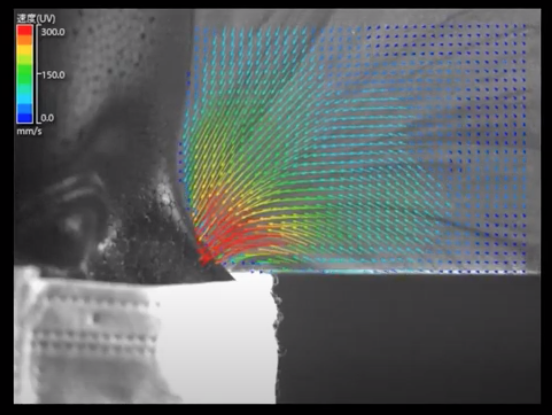
The filter pressures the airflow, and the air always tries to find an easy way. The air is likely to leak around the nose, the cheeks, and the chin.
But the test also shows that if you wear a surgical mask with a nose wire properly to cover your whole chin and jaw, it reduces the leak significantly.
Then I found an amazing product. A mask sealer from a Japanese company which manufactures special materials in medical fields, robot technology, and space projects.
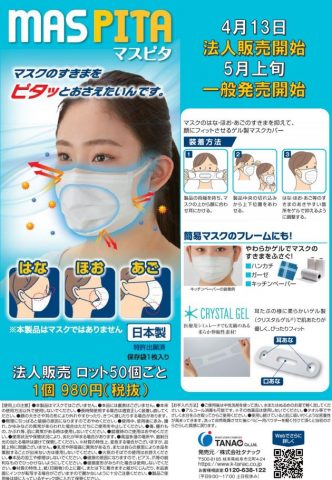
This gel sheet can stretch 1000 times and seal your mask softly but firmly to your face. This mask sealer can reduce the air leak down to 20%. The sealing around the chin and the cheeks is excellent. We can feel a little air leaking along the nose.
The combination with The Beak is extremely good. Here’s the pattern sheet of The Beak version 2 which is designed to use with the mask sealer.
The best thing we can think of if you want to stop the 20% leaking around the nose is to fill in the gaps with cotton balls. Cotton balls do excellent mechanical interception as a filter just as a cotton kilt. I think that, as a solution, filling with the cotton filter is better than trying to fit tightly to different faces to avoid leakage.
We will share more about the updated Beak to be used with the mask sealer soon. We are preparing to have this mask sealer available for Watsuers around the world too.
FINDING 8
Don’t use a mask with a valve
This is a sad misunderstanding.
Just like N95 mask for the medical use, there is a highly efficient DS2 mask for construction workers. While the medical mask is supposed to block the air in and out to prevent infection, DS2 mask is supposed to only block dusts, gas, and particles from coming in. It’s got a valve. The valve closes when inhaling so that the air comes in through the filter. It opens when exhaling so that the breath goes out without filtering.
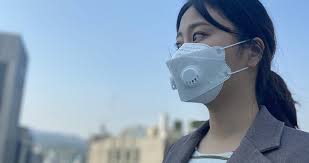
Your breath goes out without filtering,,,
Does that help to stop the spread of COVID-19?
We have discussed that many carriers have no symptoms, that PCR testing makes a lot of false-negative, and that many infections come from non-symptom or pre-symptom carriers. We should think anybody can be a carrier, and that includes ourselves. You are never sure that you are not infected just because you have no symptoms.
FINDING 9
Ventilation is the best protection for Aerosols
I see that there have been discussions about whether or not COVID-19 virus is really transmitting through air (aerosols). Theoretically, it’s possible, but is it really happening in many cases?
It has been believed that bigger droplets and contacts on the infected surface are the major source of transmission. W.H.O. has been taking this position. Many doctors point out that the best to expect from wearing the regular mask is just to prevent yourself from touching your face directly with your hand, and that the regular mask is almost no good for protecting from aerosols.
On the other hand, I just read an article that 239 scientists sent a later to W.H.O. that COVID-19 virus is airborne and suggested that W.H.O. should emphasize more on protecting from the aerosols.
239 Experts With One Big Claim: The Coronavirus Is Airborne by New York Times →
When it comes to aerosols, I see not so much we can do with our PPE, since I still think that we should keep N95 masks reserved for medical professionals. We can try to do better with the mask. We can improve the protection by wearing the mask sealer and by having our clients wear a mask with The Beak. All these efforts count, but the actual effect to protect from aerosols should be far from perfect.
I think ventilation is the best protection for aerosols.
The virus doesn’t have wings to fly. They are just floating in the air. Aerosols just go where the air flows. Ventilation at your pool is the key. As a Watsu professional, your protective measures can be different, depending on how much ventilation your pool has. An outdoor pool. An indoor pool where windows can open to all directions. Or an indoor pool with a ventilation fan to circulate the air. Good ventilation in these places may allow you to do with the minimum protection for aerosols.
For contact transmission, your pool needs to be sanitized properly. Any surface people tough should be sanitized. Make sure everybody to take a good shower to reserve free chlorine in the pool. And you should be wearing a mask not to touch your face.
For droplet transmission, accidental coughing or sneezing can happen during the session, so you just want to prepare for that. Big droplets come flying in trajectory. They don’t float around like aerosols. So any face covering and eyeglasses will do. You just have to be careful when you take them off and wash to disinfect.
For aerosol transmission, it depends on how much you want to protect, but you can count on the good ventilation. The biggest question would be whether or not you have your clients wear a mask. That actually makes a big difference in the client’s comfort. Wearing a mask while floating may possibly bring out trauma in some clients.
However, if the pool is indoor with poor ventilation, I would really prepare the maximum possible protection and explain it and the risks well to the clients in advance. I would consider not doing Watsu in the closed pool, too.
For me as an example, our pool is indoor with a big ventilation fan. But because of the location of the windows that open, half of the space has good air circulation and the other half has not so good. We just restarted the sessions in July. Therapists wear a surgical mask, The Beak, and the mask sealer. Some therapists want to fill in the nose gaps with cotton balls to be more secure.
Clients wear a surgical mask and The Beak. Personally I would feel safe to have the clients with no mask, given the ventilation we have at the pool. But other therapists wanted more protection for droplets, so we decided to put a mask on the clients.
But I don’t feel ready to open classes yet. Classes have much longer hours, more people in the pool, more talking and laughing, and just more interactions in and out of the class. I don’t feel comfortable yet with all the possible protections I can think of now.
FINDING 10
Choose your protection level of appropirateness
In this COVID-19 pandemic, We know that many infected people experience no symptom or minor symptoms. They say underlying medical conditions are likely to cause complexity and aggravation, but also they observe young healthy people are getting aggravated sometimes. Doctors in the front line say this virus surprise them every day. A recent study shows that this virus has mutated and gained a new type of spike which makes it more contagious.
On the other hand, 100% protection is not possible. And the economic impact is huge. We will have to find a balance point somewhere, keeping the economy going and keeping the medical capacity at the same time. We’ve seen countries had different strategies. Some tried to bring new infections to zero or close. Some tried to keep it under the medical capacity for the least possible mortality.
I think we should look at the infection risk and aggravation risk separately when we access the situation we are in. This virus does not have high mortality rate in its nature. But it’s so contagious and the volume can become overwhelming to pressure the medical capacity. With no proper medical help, COVID-19 is deadly. When we plan our protection measures, I think we should access the situation of the area and the country, and try to find the protection level of appropriateness, rather than just trying to avoid the infection 100% all the time.
What protection level would you settle for? What kind of PPE would you wear? What kind of PPE would your put on your clients?
This appropriateness depends on many factors, and it can not be one that suits anyone and anywhere. Ventilation of the pool is a big factor as we discussed. Your personal situation, like your occupation or your family members, can be another factor. The appropriateness also depends on what kind of situation your country is in. For example, USA is having a surge now, reaching close to the medical capacity (or reaching over) in some areas. On the other hand, Taiwan hasn’t had a new infection since early May, except for the ones who came back from overseas. (As of July 7, Taiwan has had 449 cases, 7 depths, in 23 million population)
The appropriateness can different in every country and region, and in every pool. And the appropriateness changes according to the changing situation and status your country is in.
We can also put out in front that those with medical conditions such as diabetes, high blood pressure, and cardiovascular problems which can be aggravated by COVID-19 should refrain from Watsu sessions for the moment.
We should keep checking on the updates, not just the number of new infections, the local guidelines, ICU bed availability, and the latest scientific findings of the virus. And be clear, flexible, and informative about your practice with the guests.

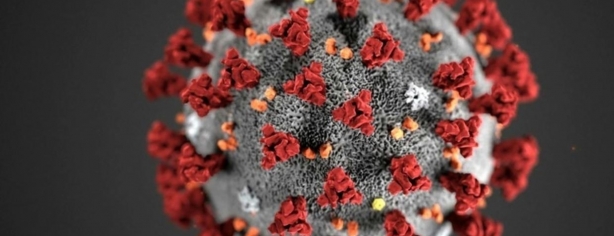



















Leave a Reply